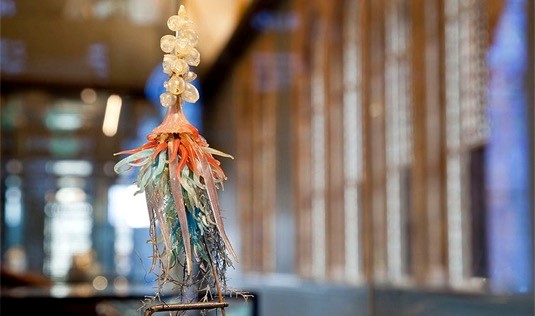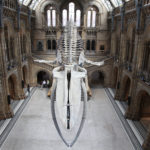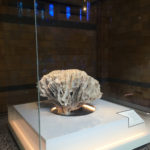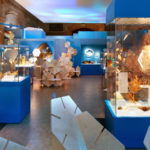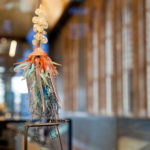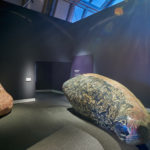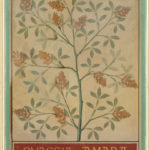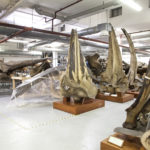Curating Ocean Ecology at the Natural History Museum: Miranda Lowe and Richard Sabin in conversation with Pandora Syperek and Sarah Wade
Article DOI: https://dx.doi.org/10.15180/201314
Abstract
The current ecological crisis and the call to decolonise museums can be catalysts for change, manifested both physically through exhibitions or redisplays of historical collections and conceptually through new curatorial approaches or interventions. This interview examines the strategies and considerations involved in a major redisplay at the Natural History Museum, London, in 2017. Here, ‘Dippy’ the Diplodocus was removed from the prime central hall location, causing a furore that soon gave way to celebration of its newly installed resident ‘Hope’ the blue whale, heralding a new paradigm of scientific display where an anthropogenic extinction narrative took centre stage in a world-renowned museum. Alongside the blue whale, a series of ‘Wonder Bays’ were installed which tell stories of evolution, biodiversity and sustainability. Curators Miranda Lowe and Richard Sabin discuss these recent displays in relation to extinction narratives, public ecological awareness, ideals of authenticity and the crossover of art and science. They reflect on how the politics of natural history display extend to broader global issues, including the illegal wildlife trade and decolonising the museum, focusing on presentations of marine life and ocean ecology to reflect their principal areas of expertise and the Natural History Museum’s recent ocean-themed programming.
Keywords
anthropomorphism, art and science, authenticity, biodiversity, Blaschka, coral, coral reefs, Curating, decolonisation, dinosaurs, ecology, exhibitions, extinction, illegal wildlife trade, museology, Museum Detox, natural history, Natural History Museum, naturecultures, ocean ecology, whales
Introduction
https://dx.doi.org/10.15180/On Earth Day 2019, the activist group Extinction Rebellion staged a ‘die-in’ under the blue whale skeleton in the large main hall of the Natural History Museum, London. The action, comprising more than a hundred people lying on the floor in protest against the Sixth Mass Extinction, cemented the status of the recently redisplayed central specimen as signifying a new paradigm of scientific display, one defined by a shift in the way that extinction was presented to the public in a world-renowned national museum. Unlike the long-extinct Diplodocus specimen known as ‘Dippy’ that formerly graced this prime position in the Museum, the whale tells a very different story of an extinction that was nearly brought about, but staved off by humans. She symbolises the ability of humans to work together to bring a species back from the brink, offering a more positive spin on an extinction narrative: her name is ‘Hope’.
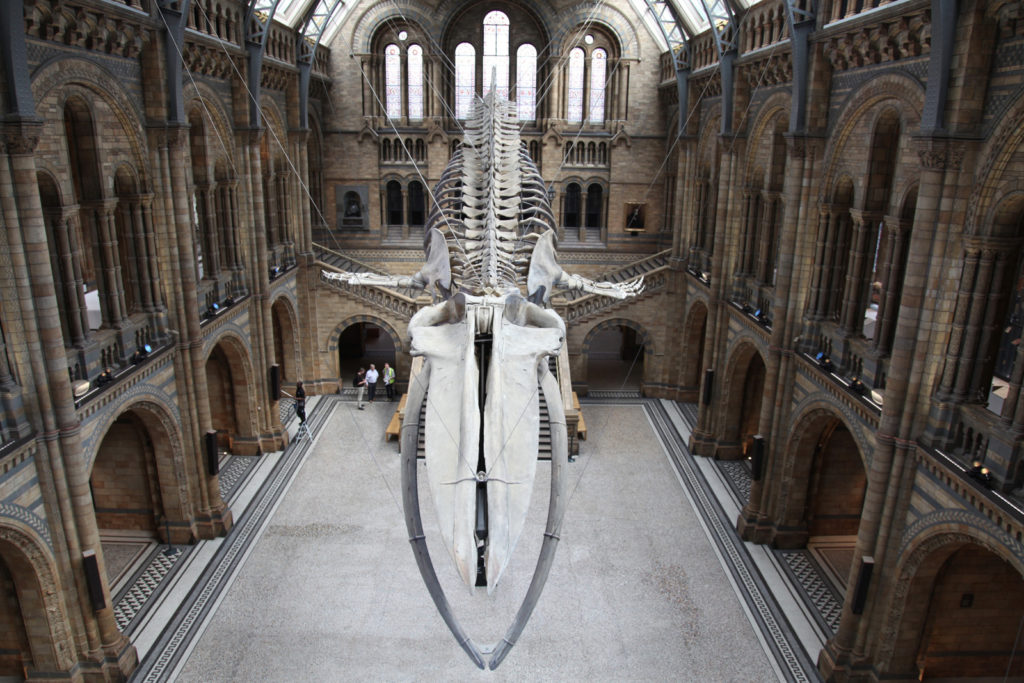
A national museum placing ocean ecology and a contemporary extinction narrative centre stage marks a significant development, one that speaks to a cultural history as much as a natural history and indeed their very inextricability from one another: beyond the science of her posture and the anatomy of her bones, Hope tells a tale of a species ruthlessly hunted for financial gain and saved from extinction by international cooperation via a whaling moratorium. Notably, this redisplay has been followed by the Natural History Museum’s declaration of a Planetary Emergency in January 2020 together with a strategy in which the Museum commits to tackling biodiversity loss, expanding on the ways it engages the public in ecological issues and delivering on an ambitious sustainability plan (Natural History Museum, 2020).
Yet, the installation of the blue whale also brings up other significant naturalcultural (Haraway, 2003) issues around curating, such as the role of anthropomorphism, authenticity, and the aura and affect of museum objects – the public emotional attachment to the dinosaur skeleton cast which had resided in the hall for nearly forty years was so strong that a petition was launched on Change.org to ‘Save Dippy’ from removal. Meanwhile, the display of the whale, a Victorian specimen that had been found beached off the coast of Wexford, Ireland, and which now swoops theatrically overhead via a complex feat of engineering, presents a dynamic new mascot for the twenty-first-century Museum.
Despite their differences – one a male-gendered cast of an ancient and earthbound creature, the other a recently rearticulated skeleton of a contemporary oceanic female mammal – a defining feature that unites Dippy and Hope is their monumentality. They were both conceived on a spectacular scale. However, the transformation of the Hintze Hall (named after donor Sir Michael Hintze in 2014) additionally included numerous smaller, heterogenous specimens in its recessed spaces known as ‘Wonder Bays’. These ten diverse displays tell the story of life on Earth, from the Great Oxygenation Event through to extinct and extant species, and remind viewers of its fragility.
The installation of Hope coincided with the delivery of a new oceans-themed programme in the Natural History Museum, which included the exhibitions Coral Reefs: Secret Cities of the Sea (2015), curated by Principal Curator of Cnidaria and Crustacea Miranda Lowe, and Whales: Beneath the Surface (2017–2018), curated by Principal Curator of Marine Mammals Richard Sabin. As well as ushering in a new era in the Museum where stories of anthropogenic impact on the oceans are told, these exhibitions equally heralded new models of curating by placing emphasis on the presentation of specimens and giving a central role to Collections specialists, such as Lowe and Sabin. Sabin was jointly in charge of the reinstallation of the blue whale (Sabin and Cornish, 2019), which had previously been displayed in the Museum’s Mammals gallery, while Lowe curated the large Turbinaria coral that sits in one of the Wonder Bays.
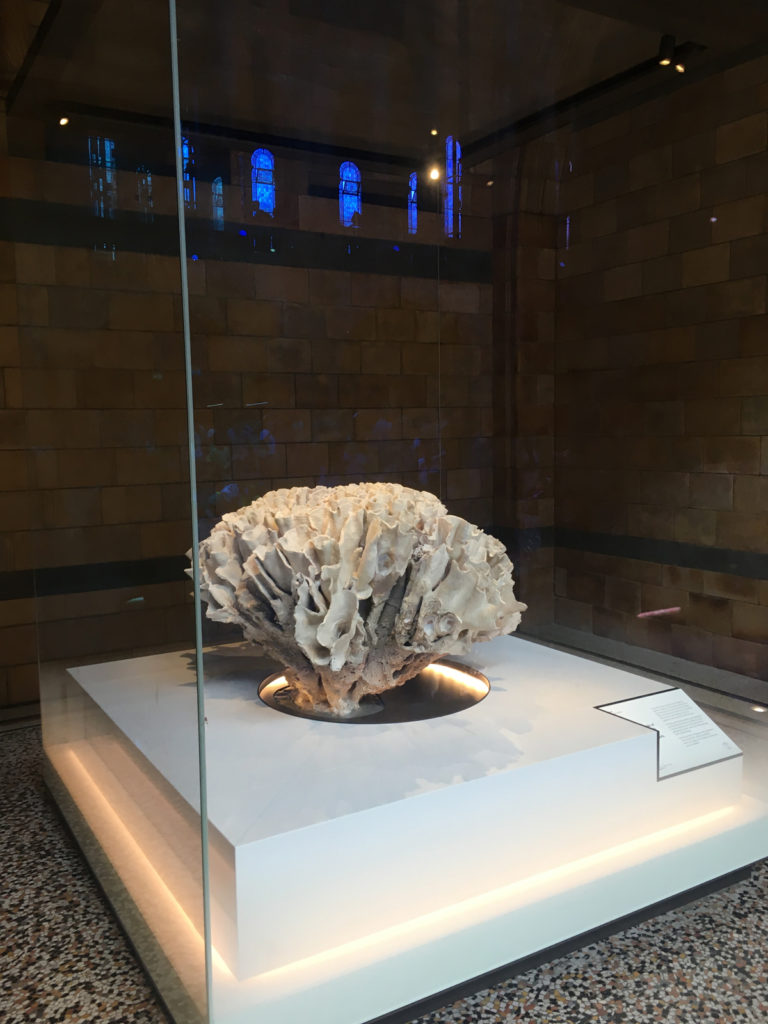
The turn to ocean ecology in recent curatorial practice ranging from large-scale permanent displays in national museums of maritime and natural history to transient exhibitions of contemporary art prompted us to embark on the research project Curating the Sea, which began with a symposium at the Institute of Advanced Studies at University College London in 2018 and will culminate in a special issue of the Journal of Curatorial Studies (Syperek and Wade, 2020). The replacement of the Natural History Museum’s much-loved dinosaur with the blue whale in 2017 was a formative moment for Curating the Sea, prompting us to approach Lowe and Sabin to discuss their work and document this moment in the Museum’s contemporary history.
Lowe and Sabin have extensive expertise in their respective fields and offer unique insight to the Museum’s collections of marine specimens, only a small proportion of which are on display to the public. In addition to Hope and the hundreds of other mammals that feature in the public galleries of the Natural History Museum, Sabin is also responsible for the mammal collections in the Museum’s expansive off-site stores, in which row after row of mounted antlers, taxidermy specimens and massive whale jaws sit for scientific and artistic study alike. Lowe complements her in-depth knowledge of marine invertebrates and dedication to creating public scientific awareness – she is a STEM ambassador – with her specialised expertise in the glass models of sea creatures made by Leopold and Rudolf Blaschka in the late nineteenth century, of which the Museum has over 180 in the collection (Syperek, 2014).
Several of the Blaschka models, along with other human-made objects including a carved nautilus shell that belonged to Hans Sloane, whose collection was the basis of the British Museum and in turn the Natural History Museum, are on display in the gallery behind the blue whale. The Treasures gallery features museum objects that are particularly inflected by human narratives. Spot lit in the small, darkened space, the displays are presented like jewels. And yet similar cultural and material histories underlie all of the collections. In new displays lining the mezzanine of the Hintze Hall, the stories of some of the individual collectors responsible for specimens in the collections are illuminated.
In opposition to the myth of science as unadulterated by art or subjectivity, Lowe and Sabin embody the dynamic realities of natural history curating. Yet they also both convey dissatisfaction with certain persistent attitudes underlying this myth: that scientific curators do not deserve the same acknowledgement of authorship that curators of art and cultural history receive, that museums of natural history are somehow less in need of decolonising than other types of museum and that contemporary issues such as the illegal wildlife trade fall outside these institutions’ remit. Both curators pursue these areas of interest tirelessly. A founding member of Museum Detox – a networking group for Black, Asian and Minority Ethnic (BAME) professionals working in museums and heritage – Lowe offers Black History tours of the Natural History Museum and has recently co-authored an article on the topic of racism in its historical foundations (Das and Lowe, 2018). Both Sabin and Lowe provide on-going expertise to law enforcement regarding the trade of endangered species. Equally, both curators have worked with artists, designers and scholars in the humanities. Here they discuss the recent transformation of the Museum’s central hall and how it reflects on naturalcultural histories more broadly in this institution.
Interview
https://dx.doi.org/10.15180/201314/002Sarah Wade: What triggered the replacement of Dippy the dinosaur with Hope the blue whale and what discussions were there around this decision at the outset?
Richard Sabin: The messaging around Hintze Hall was about the repositioning of the Museum to show our relevance in terms of our research, which includes the study of the oceans, the species that live there and ocean ecosystems. It was about changing the public perception of this museum as being primarily a dinosaur museum. One of the reasons behind the decision to replace Dippy as the central specimen of Hintze Hall was that senior staff in our Public Engagement Group had visited other natural history museums around the world and seen the changes being made and understood that we had to change with regard to refreshing our public offer. But science was also a driver for change, because we needed to ensure that our science was more visible, was seen as being world class, relevant, contemporary and part of the attempts to address the big questions facing our planet.
Miranda Lowe: I wonder whether Blue Planet II [the BBC oceanic wildlife series] was also on the radar, because it was already being filmed. The Museum would have seen an opportunity there. We already had a relationship with Sir David Attenborough, so the timing of that decision could have been related, but it was also about showing more real specimens from our collections to the public.
It was also around the time of Coral Reefs: Secret Cities of the Sea (2015), which was seen as instigating a new era of exhibitions for the Museum because it was specimen rich. It contained 250 specimens – many of which had not been seen since 1907. Outside the Museum’s Jerwood gallery, where the exhibition was held, had been the historical Coral gallery, so the location was significant. A lot of the specimens that I work with from the deep ocean are small and there are challenges associated with displaying them so that people can understand and appreciate them. This exhibition was a great opportunity to show larger coral specimens and bring them back into the Museum along with their stories, because they are usually stored offsite.
Also at that time, the Chagos Archipelago was a political issue, both socially and due to climate change studies. [The British government had faced criticism for designating that area as a Marine Protected Area (MPA) in 2010, which at that time was one of the largest in the world. Then in 2015, the Hague deemed the MPA against international law, amidst continuing litigation on behalf of displaced islanders and Mauritian sovereignty claims.] We have a huge collection of nearly 7,000 corals from that area from three expeditions in the 1970s. There were lots of requests for data at this time and I was responsible for determining how to manage that data, in turn, within a political agenda for the native Chagossians who had been moved from the islands. The Museum had to manage those climate change messages and the political issues in a certain way.
RS: The redisplay was also part of the masterplan strategy for the Museum, which stated that all of the permanent public galleries were going to be replaced, starting with a complete reimagining of everything in Hintze Hall. In January 2014, I was invited to the first meeting of the Hintze Hall Project Group, comprised of staff from across the Museum. In that initial meeting, Ian Owens, our Director of Science, said to me: “Richard, the first thing I’ve got to tell you is that from now on, you are going to be known as the Dippy Killer!” That was when the news was delivered that we were all in the room to think about a replacement for the central specimen in Hintze Hall. I had understood change was coming, but I hadn’t realised that it was going to be as substantial as taking out the iconic specimen that had effectively become the emblem of the Museum.
SW: Were there discussions around shifting ideas of extinction and the increased momentum and public awareness about ecological issues as part of that decision?
RS: Those key topics were discussed when, in that same meeting, we were given the criteria that needed to be addressed when deciding on the hundreds of replacement specimens needed for Hintze Hall. These were based on the Museum’s main research areas – origins and evolution, sustainability and biodiversity. We also had to take on board the additional criteria that the specimens had to be genuine. Not replicas; not facsimiles. The specimens had to be representative of our science, our research collections and they also had to have a ‘good story’ attached to them.
But then something else was thrown into the mix: the new, central specimen was not going to be positioned on the floor like Dippy; it was going to be suspended from above. This was to facilitate flow into and through the hall, into the Wonder Bays, up to the balcony level and on to other parts of the Museum. As soon as we were told the specimen had to be suspended, it reduced the number of available options. My first idea actually wasn’t the blue whale. It was the skeletons of 147 false killer whales in our marine mammal research collection, which were part of a mass stranding in 1927 from the East Coast of Scotland. I suggested creating a pod of around fifty articulated skeletons and presenting them swimming through the space, but then somebody sensibly said ‘think of all the cables’! I then realised that the biggest thing we had in our collection that addressed all of the required criteria was already on display: the blue whale.
Hope – the name ultimately given to the blue whale skeleton – has created a great visual experience: a new spectacle. However, all of the associated messaging – the significance of this being a species from a remarkably diverse group of animals taken by humans to the edge of extinction, then saved at the last minute through incredible international cooperation – enabled the Museum to reposition itself as a natural history museum for the future.
SW: I’m just thinking about the other oceanic displays present in Hintze Hall: the blue marlin, the coral and the seaweeds in the Wonder Bays. Miranda, what was your role in the decision-making about the coral display?
ML: The Hintze Hall Project Group approached departmental curators about the individual Wonder Bays, asking what the biggest thing we had in our collections was. As manager for marine invertebrates at that time, the biggest thing that I had was either the coral currently on display or a giant clam. The Turbinaria coral was displayed in Coral Reefs and I did not want it to go back into storage after that exhibition. I wanted it to remain on display to communicate an important message about the oceans, concerning biodiversity, symbiosis and the potential for coral reefs to recover from ecological devastation.
RS: There had also been discussion about the ‘Index Museum’, Richard Owen’s original plan for the arrangement of specimens in the Central Hall when the Museum opened in 1881. The Hintze Hall redisplay did not initially coalesce around the idea of the oceans necessarily. However, we were discussing an oceans season at the time, spurred on by Miranda’s Coral Reefs’ exhibition, and I was working on Whales: Beneath the Surface.
ML: Yes, that’s right. After the coral exhibition, the template going forward was that exhibitions would be specimen rich. The beauty of the coral exhibition was that after seeing the dead corals, you would go around the corner and then see the aquarium of live corals and a film about how this had been developed. That was great.
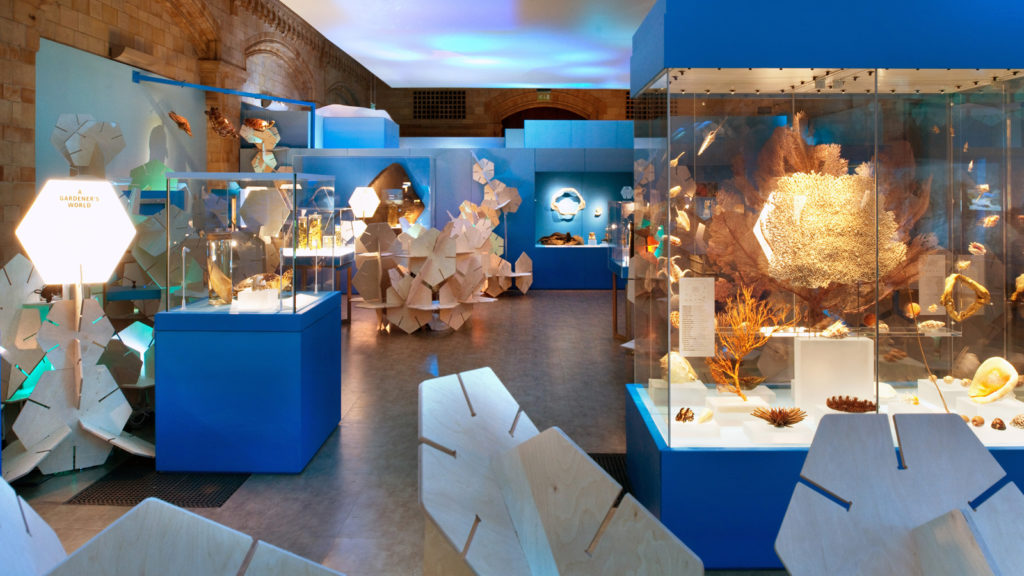
Pandora Syperek: Can you reflect on the role of the curator and the ideal of scientific neutrality when it comes to producing exhibitions? Unlike the art world, in which curators regularly claim authorship – think of the ‘star curator’ – science and natural history curators frequently work in teams and are rarely publicly credited.
ML: I have a colleague who is responsible for the Southeast Asian collections at the British Museum. When the British Museum opened an exhibition relating to these collections, as well as being the curator of the objects, she was also credited as the curator of the exhibition and profiled in the media as such. It does not necessarily happen like this at the Natural History Museum because we have an Exhibitions department and often a member of that team is credited as the curator of the exhibition. The Coral Reefs exhibition was the first time that I was credited as the curator of the exhibition as well as the researcher. It has always been an issue for me that natural history curators do not get
credited more: the Exhibitions department comes to us for the stories because we have massive insight into the collections; yet, we do not always get the recognition. It works so differently in the art world. Why?
SW: Do you think it is because of the expectation that what you are doing at the Museum, and what the public come to see, is ‘science’, and so it has to be presented as ‘fact’ rather than something that’s been constructed, which, as we all know, natural history displays are?
RS: Possibly, but actually we have engaging personalities and an ability to communicate across audiences that goes well with our jobs. Miranda and I are excellent at presenting and are both experts in our fields, so we often get asked to front things for the Museum. We are both part of a suite of collections and research individuals at the Museum that are known to be able to represent the institution well.
One of the things that really made a difference to our degree of involvement with Hintze Hall is that the Museum started to offer secondments from the science departments to the Exhibitions department. Curators would spend six months developing temporary exhibitions, contributing their in-house expertise.
ML: I did a secondment in Exhibitions and I briefly worked on the Treasures gallery because I wanted a whole gallery of the Blaschka models!
PS: This was the gallery that started to speak to the cultural history of natural history. I want to ask about the directive for there to be no facsimiles in the redisplay of Hintze Hall and that all of the specimens should be originals. This was one of the arguments driving the replacement of Dippy with Hope, because Dippy was a cast. But does the ideal of authenticity come into conflict with the ideal of spectacle?
RS: This came from our then Director of Exhibitions, who was determined that replicas should not be shown and believed that authenticity was key. I would argue that it’s a questionable position to take because Dippy is a replica of a very valuable and
fragile dinosaur fossil [the Diplodocus carnegii at the Carnegie Museum of Natural History in Pittsburgh, Pennsylvania], and if anything, Dippy has become more famous than the original dinosaur specimen in the USA. We have been making replicas of our precious fossils to send on loan to our scientific colleagues around the world for decades. Now we are routinely digitising our collections to make them more accessible and doing exactly the same thing across all taxa. People are seeing digital replicas of our collections and are fine with that, because they understand the reasons why they have been created and the roles they play in research and education. The argument that a display of a replica is somehow cheating the viewer is a weak one, when the replica itself may have a wide range of intrinsic values.
ML: When I did my secondment in Exhibitions, they were carrying out an evaluation about whether visitors thought Dippy was real or not. So, in some way those results might have determined what was to come in the redisplay.
SW: This point is really interesting in relation to your obvious obsession with the Blaschka models, Miranda. Is thinking about models versus specimens different for you?
ML: I do find myself calling the Blaschka models specimens. That’s how they are documented in the registers. They were sold under scientific names as specimens, even though they were glass models. I do separate them with regard to authenticity though – I think more in terms of the Blaschkas making the real Blaschka models, the time period in which they were made, the craftsmanship and who may have added things to them. So I look at the issue of authenticity in that context.
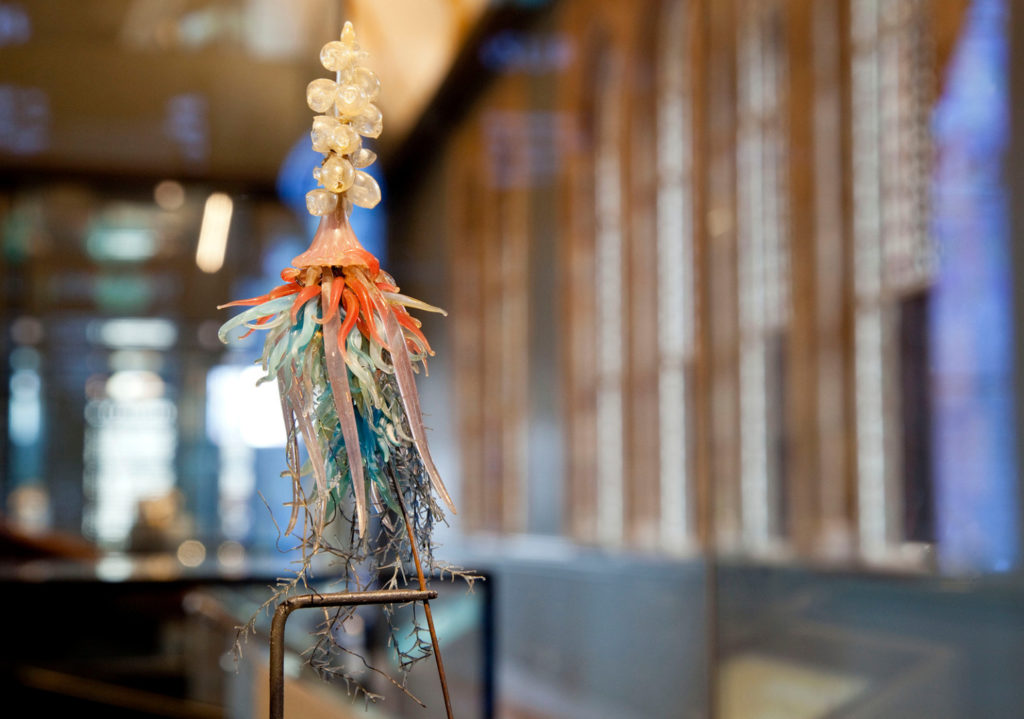
PS: Does the goal of authenticity clash with the reality of display practices then? For example, in the dramatically articulated whale skeleton in Hintze Hall, or in situations where models can communicate more successfully than ‘real’ specimens?
RS: We had to make replacement elements to include in Hope’s skeleton, so she is not entirely ‘authentic’. Back in 1891, the Museum was sent an incomplete skeleton and we didn’t realise that the technicians who mounted the skeleton in the Mammals gallery in the 1930s had used shaped pieces of wood to fill the gaps. When our conservators
got a close look at Hope’s flippers in 2016, they discovered that some of the ‘finger’ bones on the right-hand side were actually made from wood. So we used 3D digital scan data taken from the complete left flipper and then mirrored this to create models of the missing bones on the right.
We couldn’t simply have the whale redisplayed in Hintze Hall the same way that it was historically presented in the Mammals gallery. The old position – horizontally mounted, flippers flat against the sides of the body – just displayed the relative proportions of the animal and indicated nothing about its movement or behaviour. I had been following the work of a US research group for years that were placing data-recording tags onto blue whales in the Pacific, looking at their diving, feeding behaviour and general locomotion. When the BBC stepped in and started to film the Museum’s project work on redisplaying Hope’s skeleton, they invited me to work in the field with that research team. It was a golden opportunity to turn my months of reading research papers into making first-hand observations. Along with the research data, I was able to inject all of the dynamism, the acrobatics and the beautiful feeding movements that I saw directly into the redisplay of Hope’s skeleton. Her spectacular diving, lunge-feeding posture in Hintze Hall is completely based on our current scientific understanding of these animals.
SW: It would be good to talk about anthropomorphism, which was present in the title of the coral exhibition: Coral Reefs: Secret Cities of the Sea, as a way to enhance understanding. Could you speak to this from your perspective? It’s something that is often frowned upon in science, but has great potential for museum displays and exhibitions.
ML: This is the way I frame it with children. Being a STEM ambassador, I go to a lot of schools and talk about coral reefs. I use a hook about how corals are like hotels, and many different kinds of animals live there. It works because you need many levels of engagement for different types of audiences. I was ultimately happy with that title, because the exhibition was for a family audience and there needed to be multiple layers of interpretation running throughout.
Another challenge we faced was that under the ocean, the coral and coral reefs and all of the animals in this habitat are diverse and very colourful. But all of the dead coral specimens are beige! We had the aquarium at the end of the exhibition because this is what you actually see in a reef.
SW: It was a beautiful exhibition. Anthropomorphism can be strategic when it comes to engaging people with things that are difficult to understand, so it is interesting to hear you talk about how using it with children is helpful.
ML: We wanted to engage people with coral and the plight of the coral reefs. These human interactions with reefs need to be highlighted. But we did not want the exhibition to be just doom and gloom; we wanted to make clear that there are things that can be done. For example, when particular reefs die out, some species can regenerate. But are we happy with less diverse reefs? All these questions arise. One of the reasons for having the aquarium at the end of the exhibition was to raise the mood.
RS: With ‘Whales: Beneath the Surface’, initially I was really against anthropomorphism, because there has been, and still is, a tendency to use misleading language that overly humanises these animals. But I learned to embrace anthropomorphism. I understand that certain aspects of whale evolution, adaptation, biology and migration are quite complex and that the ocean is an entirely alien environment. But, ultimately, we needed to raise people’s awareness that the whales and dolphins that they are drawn to and fascinated by are air-breathing mammals just like they are, and that cetacean ancestors returned to the ocean after adapting to life on land – something that people don’t generally know. We wanted people to be able to
empathise with these animals which have adapted incredibly well over time to live in the hostile environment of the ocean, but to understand that they are now facing issues that have been created by us and our activities on land. Was an empathic response the right way to tackle things? Actually, it was difficult not to elicit that kind of response from people. One of the things that has happened in behavioural studies in natural history over the past decade is that we have realised that there are lots of species that have behaviours and cultures that are passed on through various learning mechanisms which are very comparable to those of humans. Anthropomorphism can work to find areas of common ground.
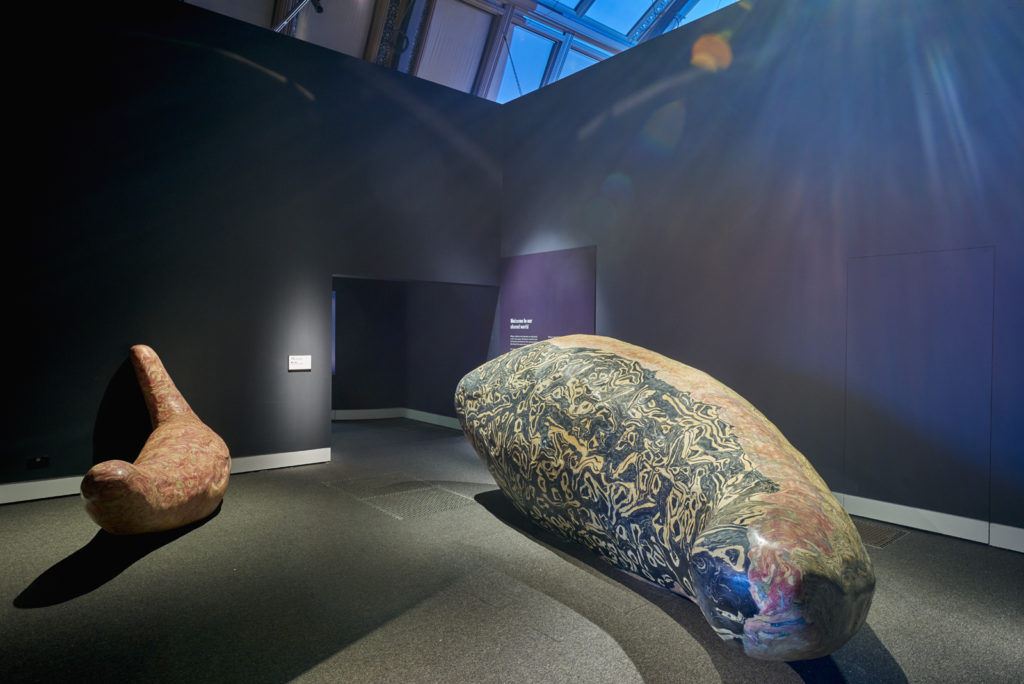
PS: Regarding how human histories feed into curating in the Natural History Museum, Miranda, could you speak to how your work with Museum Detox and your recently co-authored article with Subhadra Das (Das and Lowe, 2018) relate to your work with the nonhuman in the Museum?
ML: Museum Detox was formed in 2014, essentially out of a need for Black, Asian and Minority Ethnic professionals within the museum and cultural sector, including art galleries, archives and libraries, to find a safe space to talk about how they feel about being a very few individuals within these organisations. On that personal level it was about being a supportive collective
for those people to air their views. Initially, it was just to get together for a drink. But five years later it has turned into something much more because of the current focus on decolonisation, particularly in museum spaces, many of which, such as the Natural History Museum, are built off the back of slavery – Hans Sloane’s wife Elizabeth owned a sugar plantation, owned slaves. For Museum Detox and decolonising projects, it is about that story being told and, more importantly, being acknowledged.
The Museum and many other cultural organisations were commemorating 200 years since the end of the transatlantic slave trade in 2007. I finally got an opportunity to put the idea out there in 2017 through the Natural Sciences Collections Association (NatSCA) conference, because the theme was ‘provocations’. Subhadra Das, a curator of the Francis Galton Collection in eugenics at University College London, was thinking about racism in the collections she looks after, although they are not natural history, but it feeds in because Galton was Darwin’s cousin. Subhadra and I delivered a talk and it was very well received. After that conference we were encouraged to publish a paper. The case studies in the paper tie into Hope, because having the whale hanging from the ceiling draws people’s eyes up to look at what is known as the ‘gilded canopy’ [the Museum’s Arts and Crafts ceiling frescoes featuring botanical specimens]. I teased out one particular story about Graman Kwasi [the Surinamese freedman and healer]. It is quite a lovely story that Carl Linnaeus named the medicinal plant Quassia amara after Kwasi, that a person of colour has been acknowledged that way. However, Kwasi sold his recipe to Linnaeus’s student who brought it back to Europe, and by selling it he bought his freedom as well. You could ask: who’s profiting off that legacy of a person of colour? With decolonisation and talking about this subject, I get the sense that people are quite fearful about it within certain parts of the museum sector, because within art they have been doing this for a long time. In natural history, those stories are not cited very often.
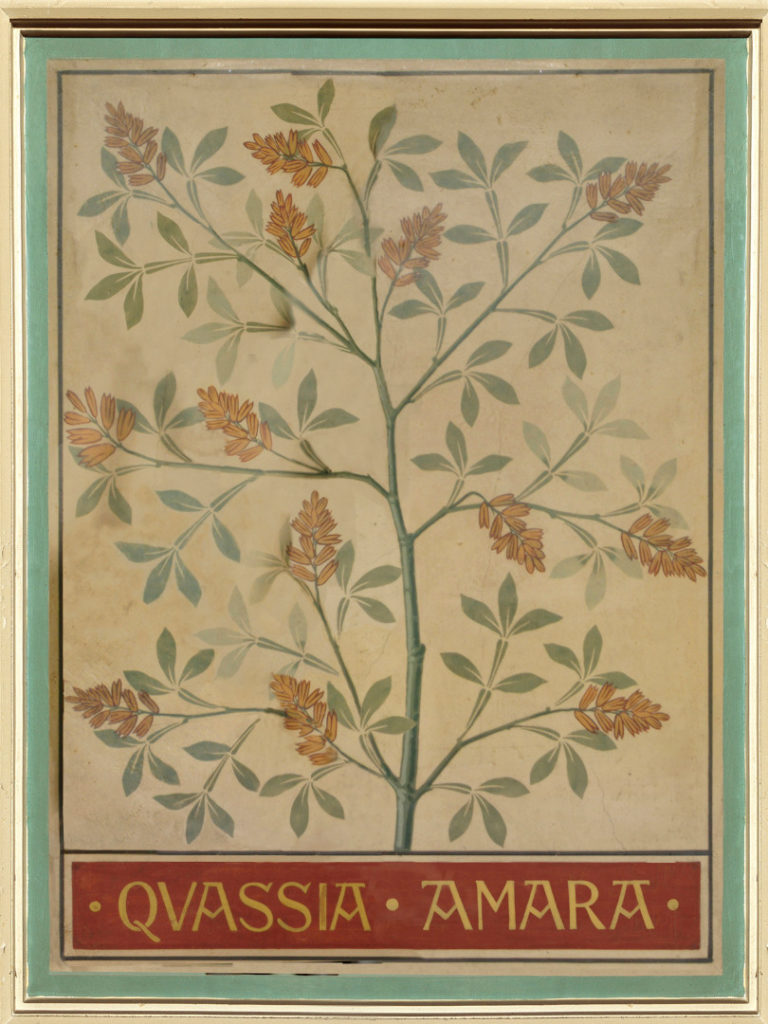
PS: You write that there is a ‘“hard science” lens’ that limits those types of stories coming through (Das and Lowe, 2018: 8). Do you think there is a shift to include more of the cultural history behind natural history within the Museum?
ML: Well, people have seen the article and they’ve seen the response. People outside of this museum and the natural history world have taken this up in all sorts of guises. I have done a Black Natural History tour of the Hintze Hall, including those stories and artefacts, or pictures of people to weave into those stories. So this is the shape of things to come.
SW: Richard, can we ask about your interest in and work on the illegal wildlife trade and how you marry this with the curatorial work you do at the Natural History Museum?
RS: Since working as a mammals curator at the Natural History Museum, I have developed the identification work I do in support of the UK Wildlife Crime Unit and international endangered species law enforcement. I conduct identification of materials seized by law enforcement agencies, using the research collections at the Museum as reference. Though this actually only represents a small part of my job, the significance of biodiversity loss, ecosystem degradation and extinction of species are always at the forefront of everything I do. A significant percentage of the species that I work with are on the International Union for Conservation of Nature (IUCN) Red List, meaning they are threatened, endangered or critically endangered. This influences everything we do, from how we manage the security of our collections, to dealing with permits and licencing for specimens being sent out on loan to other institutions, to the way that we develop content, narratives and interpretation for our public exhibitions.
SW: Is there anywhere in the Museum where that story is told?
RS: Not explicitly. Certain installations such as the world record African elephant tusks in the Mammals gallery do address poaching and the illegal wildlife trade, but this is focused very specifically on elephant ivory and not the broader, global issues or the cultural drivers behind some of these.
SW: It comes back to the issue that cultural history is not always present in the Museum.
RS: We have begun to present in more detail the origins of natural history as a discipline and some of the key founding individuals who are associated with the Museum on the Hintze Hall mezzanine level. However, there is much more that we could do to explore changing societal and scientific attitudes towards collecting and our relationships with the natural world through time. Our former Director of Science, Ian Owens,
wanted the new Hintze Hall to be a place where visitors and staff could have challenging conversations about the issues affecting our planet.
ML: It comes back to the fact that museums are not neutral. People need to feel comfortable to have these debates in these institutions.
PS: What about your work with contemporary artists – how is that a move away from showing a supposedly neutral vision of science to incorporate cultural history?
RS: I was interviewed by an artist recently, who asked me about my thoughts on what is considered to be the separation between art and science.
I told her that I do not think there is a separation. I see art and science as branches stemming
from the same creative tree. There is a creative mind-set of observation, examination, interpretation and presentation that artists and scientists both share. Both use the same processes, but present things to audiences in very different ways. I like to think that scientists and artists see the same things, but through very different lenses. Art and science are in no way exclusive, but in fact interdependent. Consider for example the dependence that the early scientists had on artists to record and represent what they were seeing, what they were observing, often for the first time, in those centuries before the development of photography and film.
PS: The Blaschka models are a case in point.
RS: There is an artist who regularly works with me in the research collections of large mammal skeletons held at our off-site store. She is producing views of fantastic specimens usually only seen by Natural History Museum staff or visiting scientists. My hope is that we can put together an exhibition of her work to be viewed by the general public, providing another way of experiencing our ‘behind-the-scenes’ collections.
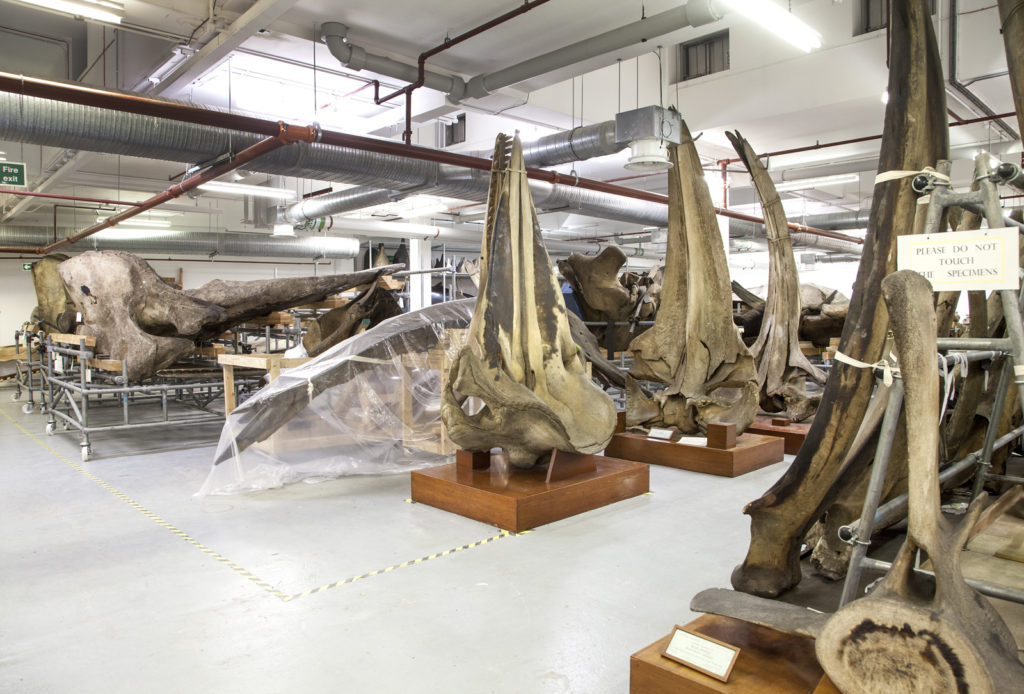
ML: I worked with the haute couture fashion designer Deborah Milner, who used to work with Alexander McQueen and focuses on ecologically aware design. She was inspired by the Coral Reefs exhibition and she emailed me to explain that she was thinking of creating a sustainable fashion range inspired by coral reefs (Regenerating the Reef, 2018). She came to the offsite store with a textile designer and beader, and they were really amazed that I let them handle the corals. It’s great working with artists. They give you other insights into what you are looking at, visually, and how they interpret it. It was really fun, me explaining the science and all about the reefs to them. Eventually Deborah Milner launched at London Fashion Week and ten per cent of the sales went to the Mesoamerican Reef Leadership Fund.
It is all interconnected and it is all beneficial. Art and design provide another hook, another way of engaging people.

